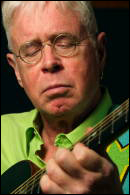Manzer Six String Cutaway Custom and Bruce CockburnBruce Cockburn has been making music for over 40 years. He plays a sort of thoughtful folk-pop that defies time and one of the guitars he uses is a Manzer Custom Six String Cutaway. Linda Manzer is a luthier based in Toronto. Manzer has been making guitars for 30 years and has made instruments for Pat Metheny, Carlos Santana, Gordon Lightfoot and many others.
 "It was custom made for me and I don't know if it corresponds to one of her
regular models. It is a six string cutaway with a cedar top and rosewood
back and sides. I think it is Brazilian but it might be Indian." says
Cockburn. "It is a little deeper than the standard depth which gives it more
bottom end. It shows the wear but it sounds great."
"It was custom made for me and I don't know if it corresponds to one of her
regular models. It is a six string cutaway with a cedar top and rosewood
back and sides. I think it is Brazilian but it might be Indian." says
Cockburn. "It is a little deeper than the standard depth which gives it more
bottom end. It shows the wear but it sounds great."
This instrument was made in the late 80s.
When Cockburn is looking for a guitar the tone of the guitar obviously matters but as important is how he plays.
"I am a finger picker but I don't use finger picks. I like a big bottom end because my thumb does a lot of the work. I like top end to sing by that I mean I want a certain response and sustain," he says."When you get a guitar brand new-especially a custom, it goes through changes-it takes a few months to settle down. Now it is aged and beautiful."
Not everyone loves this guitar the best.
"My sound guy prefers the other one because he has to roll the bottom end off this one. But when you here it acoustically?" says Cockburn.
Cockburn says that, when in the studio, he relies on whoever is producing to pick and place microphones on the guitar. He says he isn't overly knowledgeable about mics (adding that he has, obviously, over the years learned a bit!). Generally speaking, they record using the guitar's Fishman Prefix Pro pickup, the guitar's internal microphone (an Audio Technnica) and two external mics. And then mix the tracks based on which sounds best, best captures the sound the producer and Cockburn want on a given song.
Sometimes there have been variations on this theme.
"When we did the live album in 79 the producer brought 4 or 5 different mics and set them up," he says. "When we miced it used whichever sounded best, or mixed them together."
The early 70s albums have two 57s in front.
Cockburn notes that, when he started playing, acoustic guitars didn't have pickups.
"Basically you played in front of a mic, which limited your stage movement significantly." he says.
No wonder Bob Dylan went electric.
Cockburn thinks musicians, and to some extend sound engineers have been spoiled by pickups. Both players and sound people have gotten so used to pickups that micing guitars from the stage is a little bit of a dying art. It isn't that Cockburn doesn't see the upside though or lament this too much.
"It is hard for me to hold a guitar right in the sweet spot. It is too distracting to think of where the mic is," he says. "But it sounded pretty good when you got it right. You'd hear one mic more than another but when they put it together you got more of the sound of an acoustic."
Live Cockburn runs the pick up through effects, splits it into stereo. The mic goers right to the board.
"I don't need to hear it (the mic) in the monitors," says Cockburn. "You get atmospheric quality only a mike will give and it makes it more like how an acoustic sounds. Mic on its own too much bottom and it will squeal."
Cockburn's current tour started in Western Canada and headed east. In May/June he will be in New York.
"The venues are mostly theaters, one or two clubs, generally larger in Canada than the states. Parts of the states where I have had fans the longest are larger," he says. "You take pot luck, depending on what venue is available and whose size is appropriate."
He plays in venues ranging from Toronto's Massey Hall and its 2700 capacity to the much more intimate Chicago Old Town School of Folk Music venue.
His new record, Small Source of Comfort, comes out March 8. Songs on the record were inspired by Cockburn's recent trip to Afghanistan to visit Canadian troops.
"At my age they feel like they (the soldiers) my kids," he says. "I think of young men losing their lives and want to let them know there is not an 'us vs them' mentality between the public and them."
His brother had been a doctor for years. He joined the army 3 years ago and did a 6 month tour in Afghanistan. He worked on the Canadian army from one end and his brother from the inside and it all came together.
"I wanted to go, felt it was meant to be." says Cockburn.
Bruce Cockburn will be out on the road supporting the new record through June, 2011.